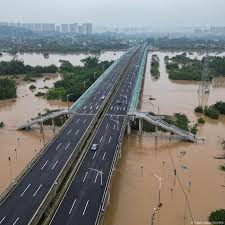China floods: At least 27 houses, 16 bridges damaged in Yunnan province; more rain expected

Heavy rains have caused widespread flooding and landslides in Yunnan Province, southwestern China. The downpours damaged at least 27 houses and destroyed or severely damaged 16 bridges. Authorities remain on high alert because more rain is expected in the coming days. This raises concerns over further destruction and possible casualties.
Flood Impact on Communities and Infrastructure
The mountainous Nujiang Lisu Autonomous Prefecture faced the worst flooding. Persistent heavy rainfall and rugged terrain caused flash floods and landslides. These disasters swept away homes and vital infrastructure. Local officials reported that floods affected about 4,857 residents. They evacuated 1,342 people to safer locations. Fortunately, no casualties have occurred so far.
Besides damaging homes, the floods destroyed many bridges. Sixteen bridges collapsed or suffered severe damage. This disruption cut off transportation and access to essential services. Many communities became isolated, which complicated rescue operations and aid delivery. Local authorities are working around the clock to assess damage and fix the most urgent repairs. However, harsh weather and difficult terrain slow their progress.
Landslides and Road Blockages
In nearby Diqing Tibetan Autonomous Prefecture, heavy rain triggered severe landslides. These landslides blocked important roads and cut off some communities. Rescue teams struggled to reach those stranded. Dense fog added to the danger by reducing visibility and increasing accident risks.
Rescue workers rely on special equipment and local knowledge to navigate damaged roads. In the Meri Snow Mountain scenic area, authorities evacuated 300 tourists and hundreds of local residents. This move was a precaution to protect people from possible landslides or floods.
Emergency Response and Evacuations
The provincial government mobilized rescue teams, medical staff, and volunteers to help affected residents. They set up evacuation centers to shelter displaced people. These centers provide food, water, and medical supplies. Authorities also plan to establish temporary shelters near damaged areas to support relief efforts.
Officials urge residents near rivers and unstable slopes to stay alert. They ask everyone to follow evacuation orders promptly. Early warning systems, including sirens and public announcements, inform people about risks and evacuation plans.
Meteorological Forecast and Ongoing Risks
Meteorologists predict that rain will continue over the next several days. This will likely cause more flooding and landslides in Yunnan. The region’s steep terrain and saturated soil make it vulnerable to such disasters during the monsoon season.
Authorities issued weather warnings and closely monitor river levels and rainfall. Hydrological stations along key rivers provide real-time data to disaster management agencies. Experts warn that ongoing rain may worsen the situation. It could trigger more landslides and flash floods, risking lives and property. Emergency teams remain ready to respond quickly to new threats.
Economic and Social Impact
The floods disrupted daily life for thousands of residents. Many families face lost livelihoods as local businesses and farmland suffer damage. Road closures hamper trade and supply chains, causing shortages of some essential goods in isolated areas.
Some schools and clinics temporarily closed due to damage or safety concerns. The provincial government promised financial aid and resources to help communities recover and rebuild after the disaster.
Historical Context and Climate Considerations
Yunnan Province often faces seasonal flooding because of its mountainous geography and monsoon climate. However, experts say climate change may be causing stronger and more frequent storms. Intense rainfall and unpredictable weather make disaster preparedness more challenging.
Authorities now review flood control measures and early warning systems to better protect communities. They prioritize investing in stronger bridges and improved drainage to reduce future risks.
Conclusion
The recent floods in Yunnan highlight the urgent need for strong disaster management and climate adaptation. Though no deaths occurred, damaged homes and infrastructure show how hard natural disasters hit communities. Continued vigilance and coordinated responses remain crucial as more rain threatens the region.
The quick action of emergency services and the resilience of residents offer hope for recovery. Still, this event reminds us of the growing dangers from extreme weather. It shows why preparedness is vital to protect lives and livelihoods.






